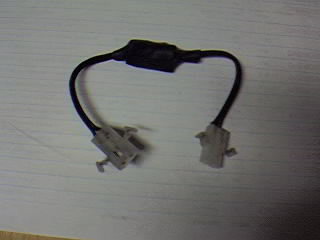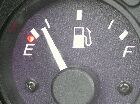Schematics:
Software utilities:
This schematic is of a small LED voltmeter that I originally designed for my motorcycle. It is fairly simple to build but requires an adjustable power supply and digital voltmeter to calibrate. If it is encapsulated in epoxy when done, it will be durable and waterproof and can be 'velcroed' almost anywhere. You will want to mount it low out of direct sunlight to make it more visible.
It is normally adjusted to light just the Red LED if the voltage is below about 12.5 volts. The Green LED begins to light at about 12.5 and the Red LED fades. At about 14.25 the Yellow LED begins to come on and by 14.75 the Green LED has faded out. It is a fairly simple and reliable circuit. I have made a couple of dozen of them.
I have found that if the Red LED stays on, you have a charging problem or too much load. If the Yellow LED stays on it is likely that the battery is low on water or you may be overcharging it.
I have also designed a smaller volt alert. It uses a single two color LED. The only problem is that you won't get an overcharge warning. But it is a simple way to get a good feeling about the charging circuit.
Schematic of the SMALL VOLT ALERT
This schematic is of a temperature controller for an electrically heated vest for a motorcycle. I use this on a Widder vest, but it should work fine with others. It uses a relay for the output, but that makes it simple, cheap, and it doesn't care what the polarity is when it is connected. And if you look at the ratings of a relay with a resistive load, it will last a long long time. There isn't an on/off switch so it must be unplugged.
The circuit works by cycling the power to the vest off and on in about 10 second intervals. The duration of the on versus off time is adjusted by the control. If set all of the way up, the off time is zero. When set all of the way down, the on time is nearly zero.
I built mine into a small box that I keep clipped onto the pocket of my jacket. I always unplug it as I get off of the bike. I use a set of jacks from Widder that are reliable, and even if it failed, I can still connect the vest directly, bypassing the thermostat. Remember the K.I.S.S. (Keep It Simply Stupid) principal, you don't want a failure in the middle of nowhere on a 20 degree day.

This schematic is meant to be added to the low fuel light on a Moto Guzzi. Without this, the light will blink for miles and miles as the fuel gets low. You also never know if the light is working if you keep the tank full.
This simple circuit can be installed in line with the fuel sending unit and dash light. The delay affect will cause the light to come on for about 30 seconds when you first start the bike. As the sending unit begins to transition on and off, the dash light will begin to glow, getting brighter with time.
You can get the correct connector at Radio Shack. Make sure you enclose the circuit to make it waterproof.
This is a simple and compact headlight modulator. From what I have been able to determine they are legal in all states for a motorcycle DURING THE DAY. It is entirely up to YOU to determine if that is true in your state AND if this design is legal. I have used one of this design or a variation of it for over 100,000 miles and never had a problem with the law or with headlight life. It definitely gets the attention of people which is normally a good thing. I will always want them on my bikes. If I get a new bike that doesn't have one yet it is very apparent.
The circuit is a simple two wire hookup that goes in series with the headlight element. The switch actually turns on, or shorts out, the modulator to turn it off. This makes a simple and reliable unit. Most of the components are available easily except for the mosfets. If you can't find them, I recommend a company called Digikey. Depending on the type of mosfet that you buy, each handles some amount of power. You can handle more power by simply putting more of them in parallel. You could also mount them on a heat sink to handle more power yet, but that would be bulky and would require insulation, etc.
Once you are sure the circuit is working, you may want to put some epoxy over it to make it waterproof and durable. I have found that the switch is the hardest part to protect from the water.
Is it my understanding that you want about 240-280 flashes per minute. Much slower and you look like an emergency vehicle. Much faster and peoples brains will "lock in" on it. All we need are MORE brain dead car drivers out there.
My motorcycles have a low fuel light, or reserves. No such thing in the
Miata. Since the motorcycles are my main transportation, I often forget to look at the
gauge when I drive the Miata. This has nearly gotten me into deep trouble twice now. This
simple light comes on at about 1/8 tank and it requires over 1/4 tank to go out. (this
helps prevent flickering on/off)
You can light a small bulb or LED. I drilled a small hole next to the E in the gauge and put a tiny LED behind it. I used hot melt glue to stick the small circuit to the gauge inside the instrument cluster, which is easy to get apart.
Often motorcycles have marginal charging systems. When you use a number of accessories such as driving lights and a heated vest, it is easy to exceed the charging system output, leaving you with a dead battery. Because I often enjoy fall and winter nighttime rides, I am using an electric vest along with extra lights to spot for any deer. My voltalert (see above) shows that the system is marginal.
This driving light controller may be the answer. It is intended to be connected through a fuse directly to the battery to drive the lights, just as you would a relay (and in fact replacing a relay). The difference is that as the voltage drops, so does the power to the driving lights. At about 13.5 volts, you are getting 100% power to the lights. At about 11.5 volts, you get about 0 power. At 12.5 volts you get 50% power.
You can add a second control input like the horns so your lights will come on when you press the horn button. Because this is a pulse width modulated system, it is very efficient. As the voltage drops and the power begins to switch, excess power should be diverted to the battery as charge current. NOTE: There is a chance that this system will cause audio noise in an on board radio system. I have not tested it.
Schematic of the Driving Light Controller
I wrote this screen save just as an exercise to prove that I could do it, and because I had been thinking about doing it for so long, it had to be done.
Simply download the file, unzip it (search the net for WINZIP for more info) and place the 'MOTOSAVE.SCR' file in your windows directory. Click your right button on the desktop, go to screensavers, and select 'motosave'. You can configure it to have sound and some other options. It works on Windows 95 and WinNT.
What you are looking at (and hearing) is my 1994 Moto Guzzi California 1100 and my 1998 Moto Guzzi V10 Centauro (in red of course). Have fun.
WHAT! A program to calculate something as easy as Ohms or Watts laws! It also does parallel resistors plus capacitive and inductive reactance. So why bother? Well, this way you don't need to remember all of the different variations of the formulas and with this you can quickly calculate things like R (resistance) if you know E (volts) and W (watts). It makes those "what if" calculation experiments go quicker.
Other then that, it doesn't have much value. So, if you want it you will need to unzip it and place it anywhere on your disk. Fill in the known values in a column, then click on the button for the unknown value in that same column to calculate it. The program will automatically transfer the calculated values to the other columns if they are needed there.
Ohmslaw zip file for the Pocket PC
This program can be used to edit a binary image from a Weber 16m injection system. You will need a prom programmer to read and write the image. Once you have an image, run the ecuedit program on it. Pass the name of the image to the program as the first agrument. If you pass a second name the program will copy the image to that second name and edit the new file.
Once in the program, select the section of the image that you wish to edit. When the section of image is displayed you can use the arrow keys, plus HOME and END to move around in the map. Then use the + or - keys to alter the value. The value will be altered by 1 hex and the new result will be calculated and displayed.
You can press 'E' to export the data to a comma seperated file to import it into a spreedsheet. Once you are done editing the data, press ESC. If any data was modified, the program will ask if you want to save the changes. If you answer yes, the changes will be written at that time.
Ecuedit for Ducati ST2 zip file
I put this together as a way to remind me of the wonderful time I had touring the Alps in 1998. The resolution of the photos is a little low to keep the file size down.
Click on the link below and UNZIP the file in your C:\WINDOWS directory. Then set it as your screen saver. This will only work on windows 95, 98 or NT.
AutoNote is a small app that will create a note file using a date format of your choice for the name. It then starts the Note application.
AutoMute is intended to turn the volume down on you Pocket PC for a specific interval of time.
Last update 5/13/07